Thankful for the Lady Bird Johnson Wildflower Center & native plants
Avoiding the Black Friday madness and taking advantage of a beautiful fall day in Austin, my family and I headed to the Wildflower Center for a post-lunch stroll yesterday. Since all the plants at the Wildflower Center are native to Texas, it’s illuminating to see what still looks good at this point in the year-long drought, with the Center following the same watering restrictions that city residents have been held to. Would you like to come along with me for a tour?
Virginia creeper (Parthenocissus quinquefolia) was blushing red along the stone walls.
Turtles sunned themselves on a rock in the entry pond, as yellow cedar elm (Ulmus crassifolia) leaves drifted around them.
The pond in the main courtyard, meant to resemble a spring-fed pool in the Hill Country, was alluring and so clear you could see all the way to the bottom—maybe 8 feet?
A Mexican buckeye (Ungnadia speciosa), like the one in my own garden, was turning buttery yellow. A trio of our native palmetto, Sabal minor, made an evergreen fringe at its feet.
On the other side of the courtyard, I admired a part-shade vignette of twistleaf yucca (Y. rupicola) and inland sea oats (Chasmanthium latifolium).
The landmark spiraling tower, seen here over a shady arbor, is also a rainwater cistern. Inside, a concrete stair spirals up to a midpoint balcony, where you can look down into the cistern’s central basin at the water collected there. Looking up, you see a grate and the sky above, as well as the feet of brave visitors who’ve gone up to the top on the narrow, exterior stair that spirals up from here.
Leaving the main courtyard and heading toward the demonstration gardens—this is a look back at the arbor seen in the previous picture.
And looking back again from a little further along
Between the openness of the courtyard and the demonstration gardens, a wooded area contains the Hill Country Stream, which meanders from left to right, necessitating at least one bridge crossing. Limestone slabs edged with cedar poles provide dry footing and safe passage across. The bags are luminarias, already set up for Luminations on December 10-11.
Why am I not growing this beautiful native shrub? Do you know it? The ID tag is below.
Southern blackhaw, or rusty blackhaw viburnum (Viburnum rufidulum). Just look at the leaves in the background—they’re like colorful stained glass.
Beautiful red leaves!
So many great understory trees grow in this area, including Eve’s necklace (Sophora affinis)—here’s the black fruit, strung like jet beads on a cord.
At the head of the stream, maidenhair fern (Adiantum capillus-veneris) softens rugged limestone.
The cinnamon-colored bark of Texas madrone (Arbutus xalapensis) begs to be stroked. Wouldn’t it be stunning in a garden?
Sadly, this tree is extremely finicky about soil and water and is nearly impossible to germinate from seed or transplant. See this article in Texas Parks & Wildlife Magazine for more info about Texas madrone.
Another rare beauty grows beside it: Sycamore leaf snowbell (Styrax platanifolius). I understand that both the snowbell and the madrone were donated by Bamberger Ranch, along with the native soil they were growing in, to ensure their survival.
Little bluestem (Schizachyrium scoparium) must be the grass of the year. I keep seeing and reading about it (see my post on Plano Prairie Garden; Scott at Rhone Street Gardens in Portland, Oregon, loves it too).
It seems fitting to stop here, with beautiful survivor little bluestem, until tomorrow, when I’ll continue my tour with the Wildflower Center’s demonstration gardens.
All material © 2006-2011 by Pam Penick for Digging. Unauthorized reproduction prohibited.


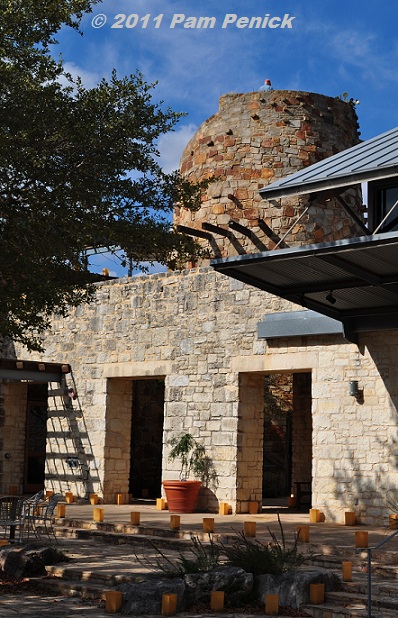
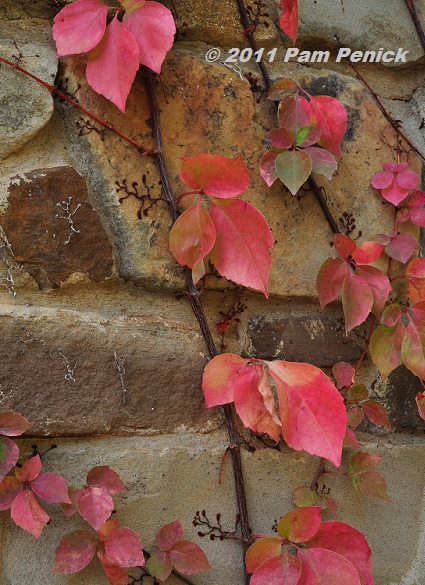
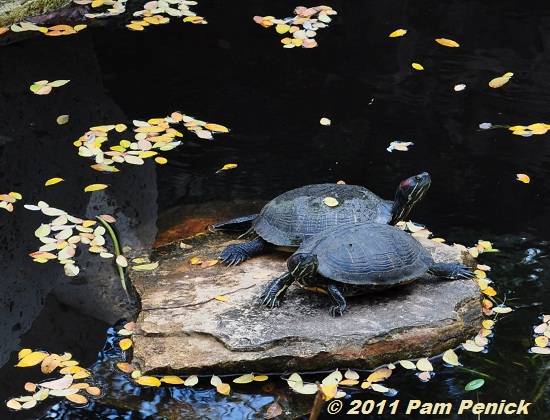
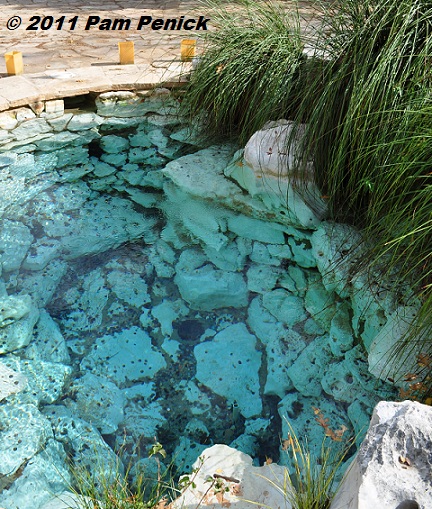
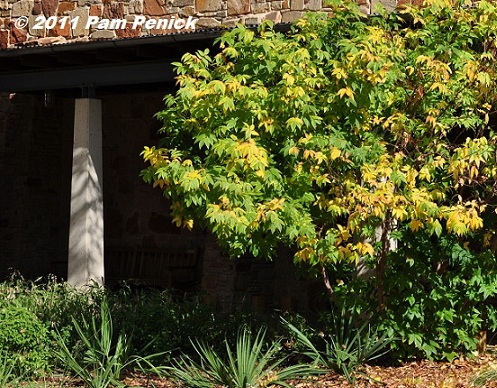
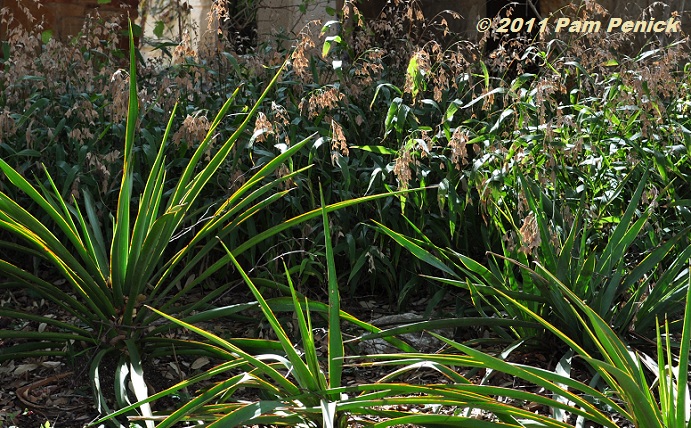
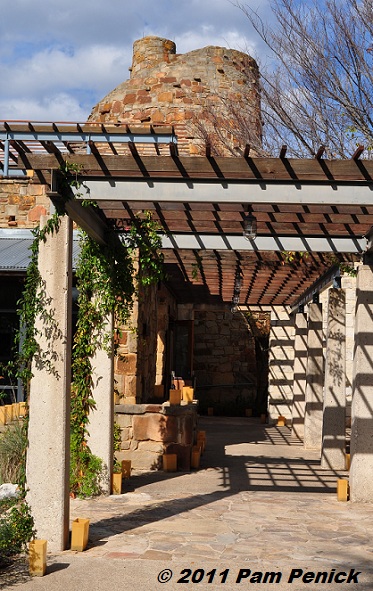
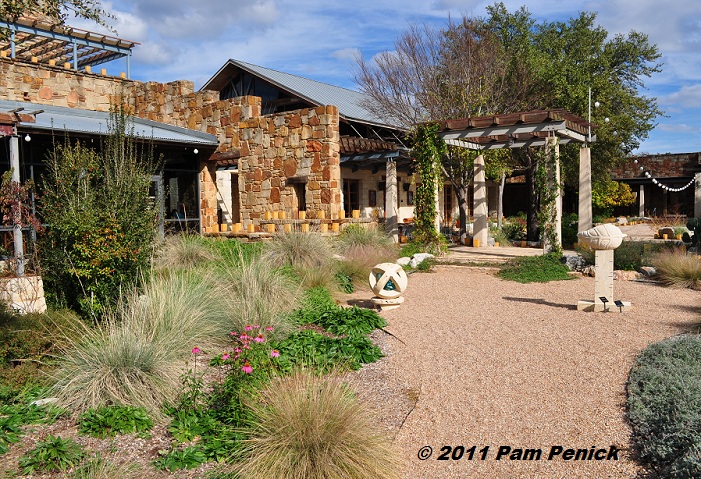
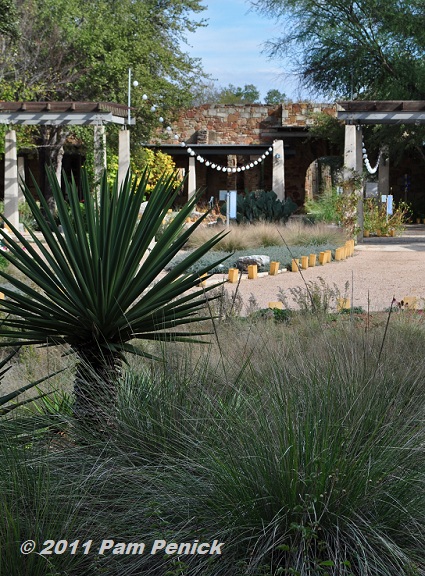
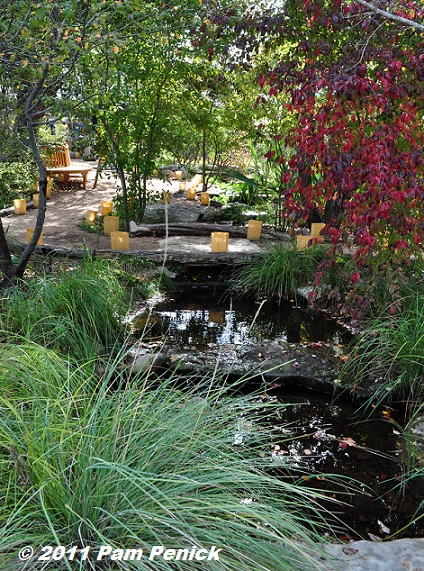
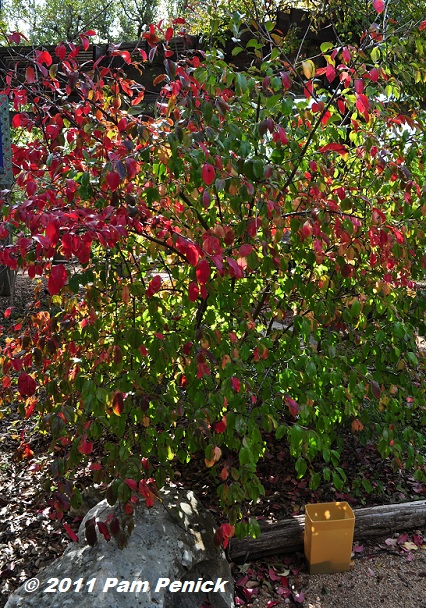
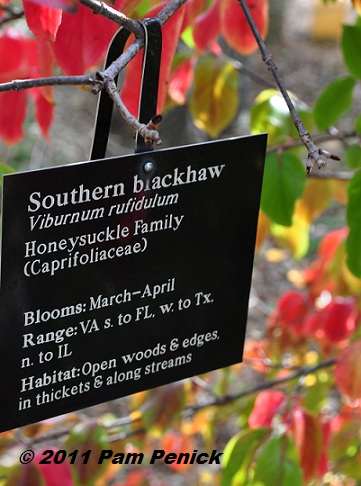
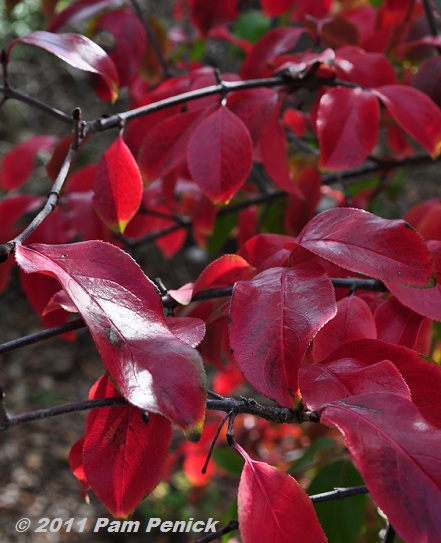
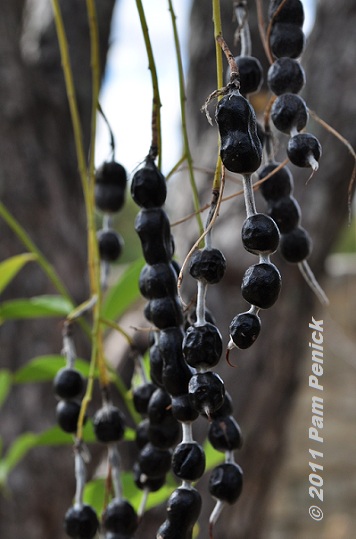
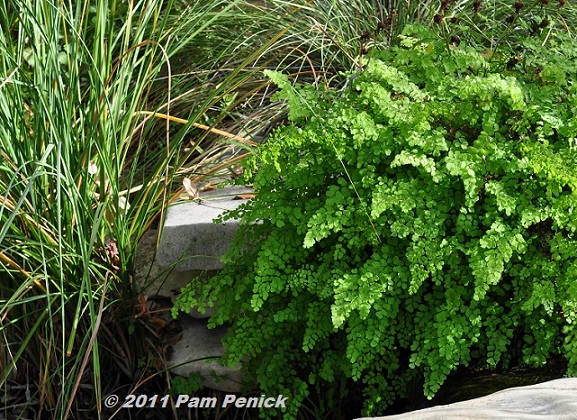
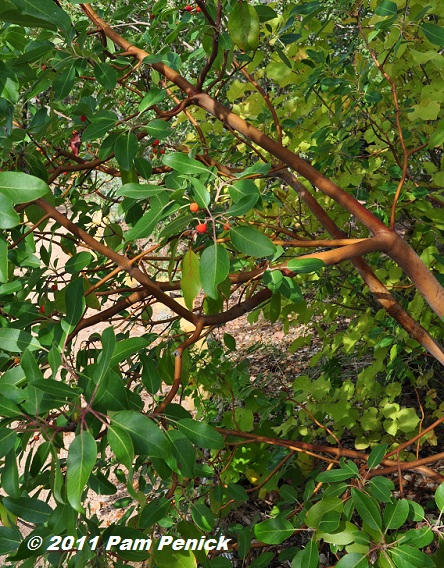
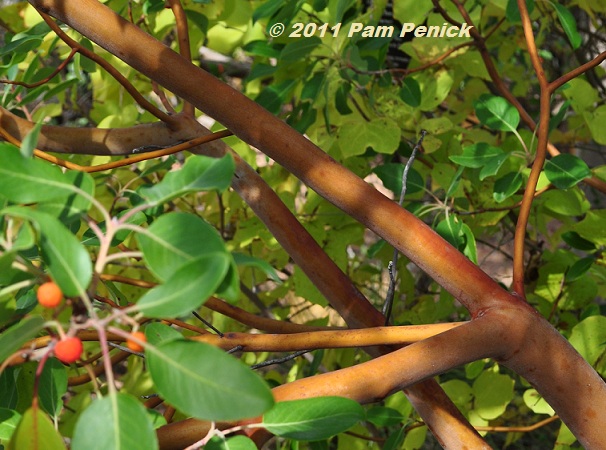
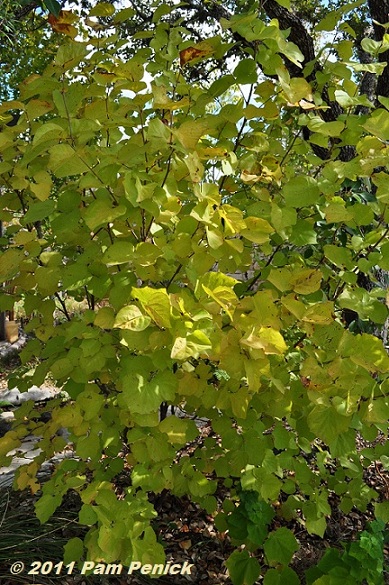
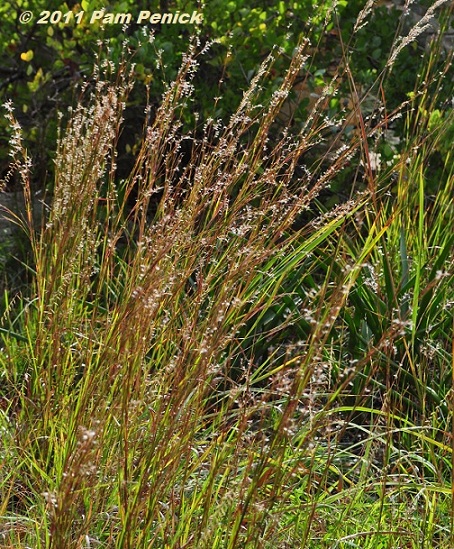
I think you need some little bluestem. The signs are everywhere. It is interesting that it is still mostly green in Austin.
I am curious. Is all of the Wildflower Center irrigated? I need to go there some day.
Despite the drought, the recent rains have greened things up a good deal. Plus, all of Austin has not seen a hard freeze yet. I’d guess the Wildflower Center has not, and neither have I on the other side of town. I believe only the main gardens are irrigated, which is only a small portion of the Wildflower Center. They announced over the summer that even though, as a public garden, they are exempt from the same watering restrictions that homeowners are subject to, they would follow them anyway. We were at 1-day-a-week watering by mid-summer, about 8 months into the drought. To my eyes, the gardens looked a bit sparser than usual, so I suspect they lost some plants or cut them back early for appearances’ sake. And the cedar brakes in the wooded areas are crispy and brown. But overall the gardens looked quite beautiful, a testament to the hardiness of native plants. —Pam
I’m thankful for such a place, too, even if it is 700 miles away! That clear pool…wow. Everything is stunning, but I like the totally different cool season look from what I saw in early Oct…that transformation is similar to Abq’s, but a few weeks later. Glad you Texans are catching on with NM’s luminaria tradition…soon, I hope to hear, “red or green, y’all?”.
Red or green? Are you talking about enchilada sauce? (Yum!) I love New Mexico and would gladly see more of its cultural traditions make their way to Texas. My extended family and I used to spend Thanksgiving in Santa Fe, and I always looked forward to the beauty of that season there. —Pam
I love both the Little bluestem and the Blackhaw viburnum. Both are beautiful and I’ve wished (many times!) that I had more room in my gardens for them. Maybe at the next house…
I know what you mean, Tina. I don’t think I have enough sun for the little bluestem, but an understory tree like the viburnum? No problem—I’ve got nothing but understory! —Pam
We called that Rusty Blackhaw in forestry school back in the day. Though common in ETX, I’ve seen it growing as an understory plant near creeks in north Collin County. The buds are rust colored which is a handy reference for winter identification. Looks like you practically had the Wildflower center to yourselves.
Yes, it’s called rusty blackhaw viburnum still; labeling it southern blackhaw was new to me. This is a hard shrub/tree to find. I’ve just called all the native-plant nurseries I know in Austin, but everyone’s out of stock. As for having the place to ourselves, yes, it was pretty quiet when we arrived, but by the time we left folks were pouring in. You’ll see other visitors in tomorrow’s pictures of the demonstration gardens. —Pam
What, you weren’t at the mall with everyone else? (neither was I…) Looks like a great way to spend a beautiful afternoon. Hope you had a wonderful Thanksgiving!
Loree, you couldn’t have paid me to shop at the mall yesterday (you either, I imagine). Plus, it would have been a crime against nature to spend such a gorgeous, sunny, comfortable day indoors. The Wildflower Center is always my solution when a day like that is presented to me. —Pam
Viburnum rufidulum is one I have been considering as an understory tree in my garden (though any planting of it will likely be next fall). Its recommended for such in the Grow Green Native & Adapted Landscape Plants booklet for central Texas. Can’t beat that fall color & think good for wildlife too.
Exactly, RBell. If I could find it for sale locally, I’d snap one up. —Pam
I’ve been to that garden and it is fabulous.
Like you, we avoided the mall and strolled in a garden. We walked through downtown Chapel Hill, through the Morehead Planetarium rose garden and then through Coker Arboretum. We’ve been having gorgeous weather.
How nice, Freda. I wish I’d visited the wonderful arboretums in the Raleigh/Durham/Chapel Hill area when I lived there. —Pam
Pam,during my time in San Antonio I searched and searched for Rusty Blackhaw as this plant had four seasons of interest. Finally found one, a puny one as most container grown RB’s weren’t real spiffy. I think they are hard to grow commercially, therefore hard to find. I think mine came from Mountain States Nursery via Hill Country Nursery. Nice tour, any Blackfoot Daisy still blooming? Greg
I’m going to locate one, Greggo. We have lots of native plant suppliers in Austin. All the ones I’ve called are out of the blackhaw right now, but I’m determined. As for the Blackfoot daisy, yep, still blooming for now. —Pam
A fascinating visit, and likely to be the closest I’ll get from Seattle. Love the idea of such a display garden.
We have a native madrone here with similar bark (Arbutus menziesii) and a small version more suited for the home landscape Arbutus unedo ‘Compacta’ or the strawberry tree. Gorgeous.
I’ve admired your native madrone and strawberry tree on blogs, Karen. They are lovely. —Pam
That Pink Guara is amazing – I have to get one for my garden.
So many great photos.
I wanted to comment on them all !
Nice Blog
Céline